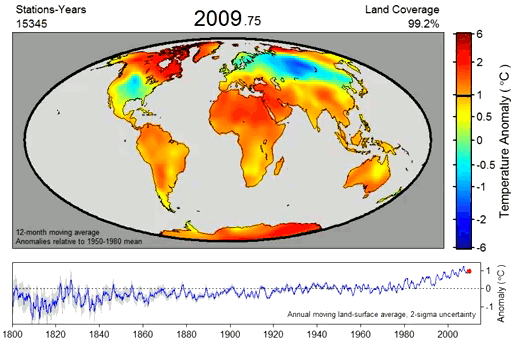The Methane Greenhouse
January 25, 2012
I reviewed the
US National Oceanic and Atmospheric Administration's Annual Greenhouse Gas Index (AGGI) in a
previous article (Global Greenhouse, December 1, 2011). This index tracks twenty
gases with a potential to trap
heat in the
atmosphere. The index increased by 29% since 1990.[1]
Five of the twenty gases are responsible for 95% of
global warming. Not surprisingly,
carbon dioxide tops the list. Prior to the
industrial revolution, atmospheric carbon dioxide concentration was about 280
parts per million (ppm). It was 389 ppm in 2010.[2] A video display of historical global warming data appears in Ref. 3.[3]
We've had problems trying to control CO
2 emission, but what about
methane, which is also a contributor to global warming? Although the atmospheric concentration of methane is small, methane is 25 times more potent a
greenhouse gas than carbon dioxide, by weight.
Methane was a fairly constant constituent of the atmosphere, measured at 1.714 ppm in 1990. It began to rise in 2007, and it weighed in at 1.799 ppm in 2010, about a 5% increase.[4] Since methane is twenty-five times more potent a greenhouse gas than carbon dioxide, that 5% increase in methane is equivalent to a 125% increase in carbon dioxide as far as global warming is concerned.

Still from the Berkeley Land Temperature Anomaly Video, showing the temperature anomaly at the end of 2009. (YouTube video).[3)]
Controlling methane, and also
soot, may be a means to control global warming, at least in the near-term. That's the conclusion of a study by a multi-national team published in a recent issue of
Science.[5-10] The article includes fourteen methods for accomplishing this goal, and the authors claim that the cost of such measures would be easily offset by increased
crop yields and lives saved.
Methane and soot (
black carbon) each have a large influence on global warming. Data from
Stanford University in 2007 partitioned the individual contributions to global warming, as follows:[11]
The proposed measures for reducing methane and black carbon emissions, which can be implemented by currently available technologies, would reduce global warming by about 0.5°
C. The measures for methane reduction would cost less than $250 per
metric ton of emissions, but the benefits would be $700 to $5000 per metric ton. The total emissions reduction plan would increase crop yield by 30-135 million metric tons per year, and they would annually prevent 0.7-4.7 million premature deaths. In the US alone, where
air pollution is much less of a problem than other countries, there would be 14,000 fewer deaths by the year 2030.[6]
The fourteen methods were down-selected from a list of 2000 using
computer models of effectiveness.[10]
Bovine methane production, which I reviewed in a
previous article (Cow Farts and Beefy Burps, March 16, 2011), didn't make the cut, since mitigation technologies have not been developed for this.[10]
What can be tackled are cleanup of cooking soot, the soot from
diesel engines; and the capture of methane from
coal mining operations,
natural gas drilling,
landfills and
farms.[6]
Wildfires, another source of soot, were not listed, since wildfire prevention would be difficult.[10] What can be prevented is burning as a means of clearing land for
agriculture.[9]
An encouraging aspect of this approach is the speed at which these methods will affect reductions in global warming. The
residence time for black carbon in the atmosphere is just a week, and methane persists for about a decade. Carbon dioxide, however, stays in the atmosphere for a hundred years.[10]
The principal problem is that many more people would be involved in the process. Carbon dioxide mitigation is usually the concern of a few major emitters, such as electrical power generation stations, but there are many sources of soot and methane.[9]
References:
- Dean Kuipers, "Greenhouse gases climbing, federal report finds," Los Angeles Times, November 11, 2011
- Trends in Atmospheric Carbon Dioxide, National Oceanic and Atmospheric Administration.
- Land Temperature Anomaly Video.
- Patricia Lang, "NOAA greenhouse gas index continues climbing," National Oceanic and Atmospheric Administration Press Release, November 9, 2011.
- Richard A. Kerr, "A Quick (Partial) Fix for an Ailing Atmosphere," Science, vol. 335. no. 6065 (January 13, 2012), p. 156.
- Drew Shindell, Johan C. I. Kuylenstierna, Elisabetta Vignati, Rita van Dingenen, Markus Amann, Zbigniew Klimont, Susan C. Anenberg, Nicholas Muller, Greet Janssens-Maenhout, Frank Raes, Joel Schwartz, Greg Faluvegi, Luca Pozzoli, Kaarle Kupiainen, Lena Höglund-Isaksson, Lisa Emberson, David Streets, V. Ramanathan, Kevin Hicks, N. T. Kim Oanh, George Milly, Martin Williams, Volodymyr Demkine and David Fowler, "Simultaneously Mitigating Near-Term Climate Change and Improving Human Health and Food Security," Science, vol. 335. no. 6065 (January 13, 2012), pp. 183-189.
- Rosanne Skirble, "Study: Slow Global Warming by Cutting Soot, Methane," VOA News, January 13, 2012.
- Christopher Joyce, "To Slow Climate Change, Cut Down On Soot, Ozone," NPR, January 12, 2012.
- Bill Sweet, "An Alternative Way to Avoid "Dangerous Climate Change," IEEE Spectrum, January 13, 2012.
- Damian Carrington, "How to tackle the climate, health and food crises, all at the same time," Guardian (UK), January 13, 2012.
- Mark Z. Jacobson, "Testimony for the Hearing on Black Carbon and Global Warming, House Committee on Oversight and Government Reform, United States House of Representatives, The Honorable Henry A. Waxman, Chair," October 18, 2007.
Permanent Link to this article
Linked Keywords: US National Oceanic and Atmospheric Administration; gas; heat; atmosphere of Earth; global warming; carbon dioxide; industrial revolution; parts per million; methane; greenhouse gas; University of California, Berkeley; YouTube video; soot; Science; crop; black carbon; Stanford University; halocarbon; ozone; nitrous oxide; celsius; C; metric ton; air pollution; computer model; bovine; diesel engine; coal mining; natural gas; landfill; farms; wildfire; agriculture; residence time.